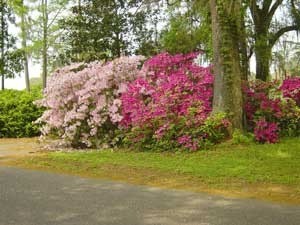
Shrubs provide the garden with structure and form. They create shade, control wind, add color and drama, and once they become established, most are easy to grow and maintain. Like other trees and plants in the landscape, shrubs give us visual clues when they are unhappy. Here are a few solutions to some common ornamental shrub problems.
Yellow leaves may or may not be an indicator that your shrub is suffering from stress.
Possible Causes: Mineral deficiencies; viral infections; incorrect moisture levels; alkaline soil; natural shedding of needles or leaves.
Solutions: The leaves on your shrubs may turn yellow if your soil is deficient in either nitrogen (widespread throughout leaf) or magnesium (restricted to edges and the space around veins). This can happen when heavy rains or excessive watering wash away crucial minerals. Performing a soil test is the only way to measure your soil for deficiencies. Applying a high-nitrogen fertilizer or Epsom salts (for magnesium) will usually correct the problem. Make sure to follow the recommended application and dilution rates.
If leaves are yellowing in distinct patterns (streaking, striping, spotting or mosaic), your shrub may have a viral infection. In many cases, treatment may not be necessary. Many shrubs can fight off viral infections without lasting effects.
Overwatering (and occasionally underwatering) can result in root damage, which causes leaves to turn yellow and drop. Make sure shrubs are planted in well-drained soil. In most cases, it's best to let the soil dry out slightly between watering. Applying a diluted fertilizer can help stimulate growth to remaining roots.
Shrubs like azaleas and some evergreens naturally shed old leaves and produce new ones on a continuous basis. Although this is usually barely noticeable, at times many leaves can be affected at once.
Possible Causes: Lack of nearby male or female plant; lack of moisture; improper pruning; stolen berries.
Solutions: Certain types of shrubs produce male and female flowers on separate plants. If you unknowingly bought just one sex or the other, or a partner shrub two doors down is suddenly removed, your shrub will not produce berries. Ask your garden center if your particular shrub type needs a partner to produce berries and be aware that even cultivars bearing female names (e.g. 'autumn lady') can still be either male or female specimens.
Too little moisture may cause berries to drop off early. Make sure you water your shrubs evenly and consistently and mulch around the base to conserve moisture.
Where there are no flowers, there are no berries. Check the correct pruning time for your shrub. Trimming away spent flowers or pruning at the wrong time can result in removing potential berries.
It's no secret that birds love berries. Netting and various scare tactics may be necessary to keep them from stealing your berry crop. Some have suggested that birds find yellow berries the least appetizing.
Possible Causes: Poor plant or planting technique; lack of moisture, incorrect soil type.
Solutions: Occasionally a shrub fails to grow or heads for gradual decline because it was compromised at the time of purchase. More often than not, however, a shrub starts to die back or fails to get growing due to improper planting techniques. Make sure you prepare the planting site with well-drained soil that has the proper pH. Plant the shrub in a hole that is twice as wide and slightly shallower than the root ball.
Possible Causes: Excessive nitrogen; improper pruning.
Solutions: Switch to a high-potassium organic fertilizer in the early spring and fall and check the correct pruning time for your shrub to avoid cutting off the wood that bears flowers buds. Shrubs that are flowering when purchased have often been forced to flower early. After getting them home and transplanting them, it can take several years for them to settle in and establish themselves before re-flowering. Once a shrub begins to bloom, you can sometimes prolong the flowering by deadheading faded flowers or cutting back the flowers borne of very short stalks.
To find out whether or not your shrub is dead or dying, use a sharp knife to remove a small piece of bark near the affected shoot. If the stem is brown and dry under the bark (not green and moist) the shoot is dead. To check the extent of the damage, make several small cuts toward the main body of the shrub until you reach healthy tissue.
Possible Causes: Winter damage; poor drainage.
Solutions: Avoid pruning too late in the season. This encourages new growth that is easily damaged by winter temperatures. The same is true of applying fertilizer late in the season. Stop fertilizing after mid-summer or switch to a high potassium fertilizer to help the wood toughen up for winter. Wrap vulnerable shrubs in a cage made of chicken wire filled with leaves or straw for added winter protection. Avoid planting shrubs in poorly drained soil. The combination of cold temperatures and wet weather in the spring can be damaging to many shrubs.

About The Author: Ellen Brown is an environmental writer and photographer and the owner of Sustainable Media, an environmental media company that specializes in helping businesses and organizations promote eco-friendly products and services. Contact her on the web at http://www.sustainable-media.com
Add your voice! Click below to comment. ThriftyFun is powered by your wisdom!